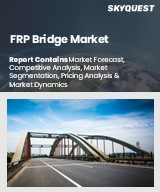
|
시장보고서
상품코드
1611643
세계의 탄소섬유 시장 - 규모, 점유율, 동향 분석 보고서 : 원료별, 견인 사이즈별, 용도별, 지역별, 부문 예측(2025-2030년)Carbon Fiber Market Size, Share & Trends Analysis Report By Raw Material (PAN-based, Pitch-based), By Tow Size, By Application (Automotive, Aerospace & Defence), By Region, And Segment Forecasts, 2025 - 2030 |
||||||
탄소섬유 시장의 성장과 동향
Grand View Research, Inc.의 최신 보고서에 따르면 세계 탄소섬유 시장 규모는 2025-2030년에 걸쳐 10.9%의 연평균 복합 성장률(CAGR)을 기록하며, 2030년에는 106억 8,000만 달러에 달할 것으로 추정되고 있습니다.
이 성장은 자동차 및 항공우주 산업에서 탄소섬유의 채용 증가로 인한 것입니다.
가처분 소득 증가와 세계화로 인한 민간 항공 수요 증가가 최근 몇 년간 항공우주 산업의 성장에 기여하고 있습니다. 스포츠 및 레저 용도 수요 증가도 이 시장에서 탄소섬유 수요를 촉진할 가능성이 높습니다.
탄소섬유 시장에서는 다양한 원료 제조업체들이 전방 통합을 볼 수 있습니다. 향상 탄소섬유의 용도는 사용하는 등급, 따라서 전구체의 품질에 따라 달라집니다.
최종 용도 부품에는 주로 자동차, 항공우주, 풍력 터빈, 스포츠 및 레저 제품 등이 있습니다. 협력하여 특정 용도로 특수 등급 탄소섬유를 개발하고 있습니다.
에너지 위기로 인해 다양한 최종 사용자가 제품의 에너지 효율을 높이기 위해 탄소섬유를 사용할 필요가 생겼습니다. 그 결과, 항공우주와 풍력 터빈 용도로 제품 수요가 급증해, 세계 시장의 성장을 견인할 것으로 예상됩니다. 또한 풍력 터빈의 설치에 대한 정부 지원 증가는 탄소섬유 수요에 긍정적인 영향을 미칠 것으로 예상됩니다.
항공우주 부문은 항공기, 로켓, 인공 위성 및 미사일의 성능을 좌우하기 위해 가볍고 강성이 높은 재료가 요구되고 있습니다.
미국과 유럽은 항공우주 및 방위산업의 주요 지역입니다. 생산이 견인하고 있습니다. 탄소섬유를 포함한 복합재료를 사용하는 주요 목적은 항공기를 경량화하고 연비 효율을 높이는 것입니다.
탄소섬유 시장 보고서 하이라이트
- 원료 기반에서는 폴리아크릴로니트릴(PAN) 부문이 2024년 매출 점유율 96.4%로 시장을 선도하고 있습니다. 수요를 견인하고 있습니다.
- 대형 견인 부문은 2025-2030년에 걸쳐 10.3%의 성장이 예측되고 있습니다. 응용 산업에서 탄소섬유의 적응이 확대되고 있기 때문입니다.
- 항공우주 및 방위 부문은 2024년에 32.2%의 최대 수익 점유율을 차지했습니다.
- 유럽은 2024년에 31.9%의 점유율로 세계 시장을 독점했습니다.
- 재생 불가능한 에너지원의 소비율에 관한 우려가 높아져, 저연비차 수요를 촉진하고 있습니다.
목차
제1장 조사 방법과 범위
제2장 주요 요약
제3장 탄소섬유 시장의 변수, 동향, 범위
- 시장 계통의 전망
- 탄소섬유 시장 - 밸류체인 분석
- 유통 채널 분석
- 규제 프레임워크
- 기술 개요
- 탄소섬유 시장 역학
- 시장 성장 촉진요인 분석
- 시장 성장 억제요인 분석
- 시장의 과제
- 탄소섬유 시장 분석 - Porter's Five Forces 모델
- 산업 분석-SWOT에 의한 PESTLE
- 시장 혼란 분석
제4장 탄소섬유 시장 : 원료의 추정과 분석
- 주요 포인트
- 원료 변동 분석과 시장 점유율, 2023년과 2030년
- 원료별, 2018-2030년
제5장 탄소섬유 시장 : 견인 사이즈의 추정과 분석
- 주요 포인트
- 견인 사이즈의 변동 분석과 시장 점유율, 2023년과 2030년
- 견인 사이즈별, 2018-2030년
제6장 탄소섬유 시장 : 용도의 추정과 분석
- 주요 포인트
- 용도변동 분석과 시장 점유율, 2023년과 2030년
- 용도별, 2018-2030년
제7장 탄소섬유 시장 : 지역별 예측과 분석
- 탄소섬유 시장 :지역별 전망
- 북미
- 유럽
- 아시아태평양
- 중남미
- 중동 및 아프리카
제8장 경쟁 구도
- 주요 진출기업, 최근의 동향, 산업에 대한 영향
- 주요 기업/경쟁의 분류
- 기업의 시장 포지셔닝 분석
- 기업 히트맵 분석
- 전략 매핑
- 기업 목록
- A&P Technology Inc.
- Anshan Sinocarb Carbon Fiber Co. Ltd
- DowAksa USA LLC
- Formosa Plastics Corporation
- Hexcel Corporation
- Holding company Composite
- Hyosung Advanced Materials
- Jiangsu Hengshen Co. Ltd
- Mitsubishi Chemical Corporation
- Nippon Graphite Fiber Co. Ltd
- SGL Carbon
- Solvay
- Teijin Limited
- Toray Industries Inc.
- Zhongfu Shenying Carbon Fiber Co. Ltd
Carbon Fiber Market Growth & Trends:
The global carbon fiber market size is estimated to reach USD 10.68 billion by 2030, registering a CAGR of 10.9% from 2025 to 2030, according to a new report by Grand View Research, Inc. This growth is attributed to the increasing adoption of carbon fiber in the automotive and aerospace industry.
The increasing demand for commercial aviation due to rising disposable income and globalization has catered to the growth of the aerospace industry over the last few years. This trend is likely to continue over the coming years as well. Moreover, the rise in demand for sports and leisure applications due to the increasing population, particularly in the Asia Pacific region, is also likely to propel the demand for carbon fiber in the market.
The carbon fiber market has witnessed forward integration by various raw material manufacturers. In-house production and utilization of carbon fiber help manufacturers cut down on logistics costs and directly cater to end-use product manufacturers, thereby increasing profitability. Carbon fiber applications depend on the grade used and, ultimately, on the quality of the precursor.
End-use components mainly include automotive, aerospace, wind turbines, and sports & leisure products. Different manufacturers serving different application segments manufacture these products. In addition, end-users have collaborated with various product manufacturers to develop special-grade carbon fiber for specific applications.
Energy crises have forced various end-users to use carbon fiber to increase the energy efficiency of products. As a result, a surge in product demand across aerospace and wind turbine applications is expected to boost the global market growth over the forecast period. Moreover, rising governmental support for installing wind turbines is projected to positively influence the demand for carbon fiber. In addition, the development of the commercial aviation segment is also expected to propel the demand for carbon fiber in aerospace applications over the forecast period.
The growing concerns regarding fuel consumption and CO2 emission levels have urged manufacturers to use carbon fiber composite materials as substitutes for metal components.The aerospace sector demands lightweight and rigid materials for usage in aircraft, rockets, satellites, and missiles as it determines performance.
The U.S. and Europe are the key regions in the aerospace & defense industry. The carbon fiber demand is attributed to the presence of significant aircraft manufacturers such as Boeing and Airbus. The aerospace industry is led by commercial aviation and the production of large passenger and cargo jets. The primary objective of using composite materials, including carbon fiber, is to modify airplanes with less weight and make them more fuel efficient.
Carbon Fiber Market Report Highlights:
- On the basis of raw materials, the polyacrylonitrile (PAN) segment led the market with a revenue share of 96.4% in 2024. The automotive industry's increasing shift toward electric vehicles (EVs) is driving the demand for PAN-based Carbon Fiber.
- The large tow segment is forecasted to grow at a rate of 10.3% from 2025 to 2030. This growth is due to the growing adaption of carbon fiber across several application industries due to its higher strength-to-weight ratio and its advantages over conventional materials, including metals and alloys.
- The aerospace & defense segment accounted for the largest revenue share of 32.2% in 2024. The Aerospace & defense sector requires lightweight and robust materials for usage in aircraft, rockets, satellites, and missiles as it assists in improving the performance by reducing the weight of the overall structure.
- The Europe region dominated the global market with a share of 31.9% in 2024. The presence of aerospace giants such as Airbus and Boeing in Europe and North America has propelled the regional demand for carbon fiber.
- The growing concerns regarding the consumption rates of non-renewable energy sources have driven the demand for fuel-efficient vehicles. This is forecasted to propel the demand for carbon fiber in the automotive application segment over the coming years.
Table of Contents
Chapter 1. Methodology and Scope
- 1.1. Market Segmentation & Scope
- 1.2. Research Methodology
- 1.3. Information Procurement
- 1.3.1. Purchased Database
- 1.3.2. GVR'S Internal Database
- 1.3.3. Secondary Sources
- 1.3.4. Third Party Perspective
- 1.3.5. Primary Research
- 1.4. Information Analysis
- 1.4.1. Data Analysis Models
- 1.5. Market Formulation and Data Visualization
- 1.6. List of data sources
Chapter 2. Executive Summary
- 2.1. Geographic Snapshot
- 2.2. Segment Snapshot
- 2.3. Segment Snapshot
- 2.4. Competitive Snapshot
Chapter 3. Carbon Fiber Market Variables, Trends, and Scope
- 3.1. Market Lineage Outlook
- 3.2. Carbon Fiber Market - Value Chain Analysis
- 3.2.1. Sales Channel Analysis
- 3.3. Regulatory Framework
- 3.4. Technology Overview
- 3.5. Carbon Fiber Market Dynamics
- 3.5.1. Market Driver Analysis
- 3.5.2. Market Restraint Analysis
- 3.5.3. Market Challenges
- 3.6. Carbon Fiber Market Analysis - Porter's Five Forces Model
- 3.7. Industry Analysis - PESTLE By SWOT
- 3.8. Market Disruption Analysis
Chapter 4. Carbon Fiber Market: Raw Material Estimates & Analysis
- 4.1. Key Takeaways
- 4.2. Raw Material Movement Analysis & Market Share, 2023 & 2030
- 4.3. Carbon Fiber Market Estimates & Forecasts, By Raw Material, 2018 - 2030 (Tons) (USD Million)
- 4.3.1. PAN Based
- 4.3.2. Pitch Based
Chapter 5. Carbon Fiber Market: Tow Size Estimates & Analysis
- 5.1. Key Takeaways
- 5.2. Tow Size Movement Analysis & Market Share, 2023 & 2030
- 5.3. Carbon Fiber Market Estimates & Forecasts, By Tow Size, 2018 - 2030 (Tons) (USD Million)
- 5.3.1. Small Tow
- 5.3.2. Large Tow
Chapter 6. Carbon Fiber Market: Application Estimates & Analysis
- 6.1. Key Takeaways
- 6.2. Application Movement Analysis & Market Share, 2023 & 2030
- 6.3. Carbon Fiber Market Estimates & Forecasts, By Application, 2018 - 2030 (Tons) (USD Million)
- 6.3.1. Automotive
- 6.3.2. Aerospace & Defense
- 6.3.3. Wind Turbines
- 6.3.4. Sports Equipment
- 6.3.5. Molding & Compounding
- 6.3.6. Construction
- 6.3.7. Pressure Vessels
- 6.3.8. Others
Chapter 7. Carbon Fiber Market: Regional Estimates & Analysis
- 7.1. Carbon Fiber Market: Regional Outlook
- 7.2. North America
- 7.2.1. North America Carbon Fiber Market Estimates & Forecasts, 2018 - 2030 (Tons) (USD Million)
- 7.2.2. U.S.
- 7.2.2.1. U.S. Carbon Fiber Market Estimates & Forecasts, 2018 - 2030 (Tons) (USD Million)
- 7.2.3. Canada
- 7.2.3.1. Canada Carbon Fiber Market Estimates & Forecasts, 2018 - 2030 (Tons) (USD Million)
- 7.2.4. Mexico
- 7.2.4.1. Mexico Carbon Fiber Market Estimates & Forecasts, 2018 - 2030 (Tons) (USD Million)
- 7.3. Europe
- 7.3.1. Europe Carbon Fiber Market Estimates & Forecasts, 2018 - 2030 (Tons) (USD Million)
- 7.3.2. Germany
- 7.3.2.1. Germany Carbon Fiber Market Estimates & Forecasts, 2018 - 2030 (Tons) (USD Million)
- 7.3.3. France
- 7.3.3.1. France Carbon Fiber Market Estimates & Forecasts, 2018 - 2030 (Tons) (USD Million)
- 7.3.4. U.K
- 7.3.4.1. U.K. Carbon Fiber Market Estimates & Forecasts, 2018 - 2030 (Tons) (USD Million)
- 7.4. Asia Pacific
- 7.4.1. Asia Pacific Carbon Fiber Market Estimates & Forecasts, 2018 - 2030 (Tons) (USD Million)
- 7.4.2. China
- 7.4.2.1. China Carbon Fiber Market Estimates & Forecasts, 2018 - 2030 (Tons) (USD Million)
- 7.4.3. Taiwan
- 7.4.3.1. Taiwan Carbon Fiber Market Estimates & Forecasts, 2018 - 2030 (Tons) (USD Million)
- 7.4.4. Japan
- 7.4.4.1. Japan Carbon Fiber Market Estimates & Forecasts, 2018 - 2030 (Tons) (USD Million)
- 7.5. Central & South America
- 7.5.1. Central & South America Carbon Fiber Market Estimates & Forecasts, 2018 - 2030 (Tons) (USD Million)
- 7.5.1.1. Brazil Carbon Fiber Market Estimates & Forecasts, 2018 - 2030 (Tons) (USD Million)
- 7.5.1. Central & South America Carbon Fiber Market Estimates & Forecasts, 2018 - 2030 (Tons) (USD Million)
- 7.6. Middle East & Africa
- 7.6.1. Middle East & Africa Carbon Fiber Market Estimates & Forecasts, 2018 - 2030 (Tons) (USD Million)
Chapter 8. Competitive Landscape
- 8.1. Key Players, their Recent Developments, and their Impact on Industry
- 8.2. Key Company/Competition Categorization
- 8.3. Company Market Position Analysis
- 8.4. Company Heat Map Analysis
- 8.5. Strategy Mapping
- 8.6. Company Listing
- 8.6.1. A&P Technology Inc.
- 8.6.1.1. Company Overview
- 8.6.1.2. Financial Performance
- 8.6.1.3. Product Benchmarking
- 8.6.1.4. Strategic Initiatives
- 8.6.2. Anshan Sinocarb Carbon Fiber Co. Ltd
- 8.6.2.1. Company Overview
- 8.6.2.2. Financial Performance
- 8.6.2.3. Product Benchmarking
- 8.6.2.4. Strategic Initiatives
- 8.6.3. DowAksa USA LLC
- 8.6.3.1. Company Overview
- 8.6.3.2. Financial Performance
- 8.6.3.3. Product Benchmarking
- 8.6.3.4. Strategic Initiatives
- 8.6.4. Formosa Plastics Corporation
- 8.6.4.1. Company Overview
- 8.6.4.2. Financial Performance
- 8.6.4.3. Product Benchmarking
- 8.6.4.4. Strategic Initiatives
- 8.6.5. Hexcel Corporation
- 8.6.5.1. Company Overview
- 8.6.5.2. Financial Performance
- 8.6.5.3. Product Benchmarking
- 8.6.5.4. Strategic Initiatives
- 8.6.6. Holding company Composite
- 8.6.6.1. Company Overview
- 8.6.6.2. Financial Performance
- 8.6.6.3. Product Benchmarking
- 8.6.6.4. Strategic Initiatives
- 8.6.7. Hyosung Advanced Materials
- 8.6.7.1. Company Overview
- 8.6.7.2. Financial Performance
- 8.6.7.3. Product Benchmarking
- 8.6.7.4. Strategic Initiatives
- 8.6.8. Jiangsu Hengshen Co. Ltd
- 8.6.8.1. Company Overview
- 8.6.8.2. Financial Performance
- 8.6.8.3. Product Benchmarking
- 8.6.8.4. Strategic Initiatives
- 8.6.9. Mitsubishi Chemical Corporation
- 8.6.9.1. Company Overview
- 8.6.9.2. Financial Performance
- 8.6.9.3. Product Benchmarking
- 8.6.9.4. Strategic Initiatives
- 8.6.10. Nippon Graphite Fiber Co. Ltd
- 8.6.10.1. Company Overview
- 8.6.10.2. Financial Performance
- 8.6.10.3. Product Benchmarking
- 8.6.10.4. Strategic Initiatives
- 8.6.11. SGL Carbon
- 8.6.11.1. Company Overview
- 8.6.11.2. Financial Performance
- 8.6.11.3. Product Benchmarking
- 8.6.11.4. Strategic Initiatives
- 8.6.12. Solvay
- 8.6.12.1. Company Overview
- 8.6.12.2. Financial Performance
- 8.6.12.3. Product Benchmarking
- 8.6.12.4. Strategic Initiatives
- 8.6.13. Teijin Limited
- 8.6.13.1. Company Overview
- 8.6.13.2. Financial Performance
- 8.6.13.3. Product Benchmarking
- 8.6.13.4. Strategic Initiatives
- 8.6.14. Toray Industries Inc.
- 8.6.14.1. Company Overview
- 8.6.14.2. Financial Performance
- 8.6.14.3. Product Benchmarking
- 8.6.14.4. Strategic Initiatives
- 8.6.15. Zhongfu Shenying Carbon Fiber Co. Ltd
- 8.6.15.1. Company Overview
- 8.6.15.2. Financial Performance
- 8.6.15.3. Product Benchmarking
- 8.6.15.4. Strategic Initiatives
- 8.6.1. A&P Technology Inc.
(주말 및 공휴일 제외)


















